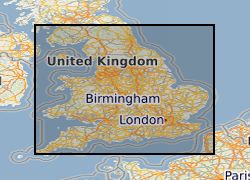Shape file
Type of resources
Topics
Keywords
Contact for the resource
Provided by
Years
Formats
Representation types
Update frequencies
Scale
Resolution
-
This dataset contains locations of worker bumblebees of five species (Bombus terrestris, B. lapidarius, B. pascuorum, B. hortorum, B. ruderatus) across an agricultural landscape centred on the Hillesden Estate, Buckinghamshire, UK. Locations were recorded in the field using a handheld GPS unit. Workers were non-lethally DNA sampled between June and August 2011, and genetic analysis used to confirm species and assign individuals to full-sib groups (colonies). Data were collected as part of a project led by the Centre for Ecology & Hydrology, funded under the Insect Pollinators Initiative. Full details about this dataset can be found at https://doi.org/10.5285/a60f52b8-0f9f-44f6-aca4-861cb461a0eb
-
Land use/land cover (LULC) map of a 20km2 agricultural landscape centred on the Hillesden Estate, Buckinghamshire, UK. The map is based on remote sensed data (LiDAR and hyperspectral sensors) with manual updates and the addition of spring and summer floral cover data from comprehensive field surveys. The remote sensed data was generated in August 2007. The manual updates and summer floral data were from field visits in July and August 2011, and the spring floral data were from field visits in April 2011 and 2012. The map was created as part of a project led by the Centre for Ecology & Hydrology, funded under the Insect Pollinators Initiative. Full details about this dataset can be found at https://doi.org/10.5285/0667cf06-f2c3-45c1-a80a-e48539b52427
-

Between 2001 and 2003 BGS received approximately 1400 1:25 000 paper maps and associated card index from the Office of the Deputy Prime Minister (now Department for Communities and Local Government (CLG)). The maps, originally compiled by the Minerals Division of the Ministry of Housing and Local Government (CLGs historic predecessor), contain hand drawn boundaries for permitted, withdrawn and refused mineral planning permissions, and worked ground. They also contain hand drawn boundaries for land use at each site. These 'MHLG' maps show information collated from the 1940s (retrospectively to 1930) to the mid 1980s. The index cards provide supplementary information regarding name, operator, dates and relevant local authority. Data depicted on the maps are for England only and include; [a] all planning appeals, departures and called in cases whether permitted or refused; [b] all planning permission and refusal data for various local authority areas which were obtained by Departmental officials through visits to authorities in a staged programme spread over many years. Priority was placed on areas that were giving rise to then current casework issues thus at the time when the maintenance of the maps ended (mid 1985), some authority information had been updated recently but other areas had not been visited for many years. [c] land use present at each site. Categories include: derelict areas, restored quarries (filled and unfilled), tip heaps and spoil heaps, and wet areas. The variable completeness of the data sets should be kept in mind when this material is being used. Land use polygons have been digitised from the MHLG maps and attribute information has been provided from the map legend and the appropriate card in the card index. The principal aim of the data is to show land use present in areas of land that have been affected by the extraction of minerals.
-
This dataset consists of the vector version of the Land Cover Map 2015 (LCM2015) for Northern Ireland. The vector data set is the core LCM data set from which the full range of other LCM2015 products is derived. It provides a number of attributes including land cover at the target class level (given as an integer value and also as text), the number of pixels within the polygon classified as each land cover type and a probability value provided by the classification algorithm (for full details see the LCM2015 Dataset Documentation). The 21 target classes are based on the Joint Nature Conservation Committee (JNCC) Broad Habitats, which encompass the entire range of UK habitats. LCM2015 is a land cover map of the UK which was produced at the Centre for Ecology & Hydrology by classifying satellite images from 2014 and 2015 into 21 Broad Habitat-based classes. LCM2015 consists of a range of raster and vector products and users should familiarise themselves with the full range (see related records, the CEH web site and the LCM2015 Dataset documentation) to select the product most suited to their needs. LCM2015 was produced at the Centre for Ecology & Hydrology by classifying satellite images from 2014 and 2015 into 21 Broad Habitat-based classes. It is one of a series of land cover maps, produced by UKCEH since 1990. They include versions in 1990, 2000, 2007, 2015, 2017, 2018 and 2019. Full details about this dataset can be found at https://doi.org/10.5285/60764028-adeb-4316-987a-14b3b21a8f9a
 NERC Data Catalogue Service
NERC Data Catalogue Service